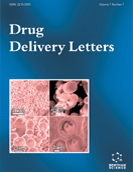Abstract
Objective: The objective of the present work was to develop curcumin transdermal films by solvent evaporation technique using Carboxy polymethylene and Eudragit RS 100 as matrix polymers. The influence of penetration enhancers: dimethyl sulphoxide (1, 2 and 3% (w/w)), tween 80 (1, 2 and 3% (w/w)) and oleic acid (1, 2 and 3% (w/w)) on the in vitro percutaneous absorption of Curcumin through the rabbit skin was evaluated.
Methods: Differential scanning calorimetry was used to evaluate the compatibility between the drug and excipients. All the prepared formulations were evaluated for moisture content, moisture uptake, flatness, tensile strength, drug content determination and in vitro permeation studies across rabbit skin.
Results: The enhancing effectiveness of the enhancers decreased in the order: Oleic acid > Dimethyl sulphoxide > Tween 80. Compared to the control formulation 1.3-fold enhancement was observed with 2% tween 80. There were no significant promoting effects at low concentrations of dimethyl sulphoxide; however, a 1.18-fold increase in Curcumin flux resulted in higher percentage (3%) of dimethyl sulphoxide. The highest enhancement factor was 1.43 with 2% oleic acid. The skin irritation tests showed negligible erythema and edema.
Conclusion: The results suggested the possibility of using formulated curcumin films in topical conditions like wound healing.
Keywords: Curcumin, carboxy polymethylene, eudragit RS 100, dimethyl sulphoxide, tween 80, oleic acid.
Graphical Abstract
Drug Delivery Letters
Title:Formulation Development and In vitro Permeability of Curcumin Films Using Different Penetration Enhancers
Volume: 8 Issue: 1
Author(s): Asif Nawaz *, Muhammad Safdar , Muhammad S. Arshad , Muhammad F. Rasool , Gul M. Khan and Muhammad Akhlaq
Affiliation:
- Department of Pharmaceutics, Faculty of Pharmacy Gomal University, Dera Ismail Khan (K.P.K),Pakistan
Keywords: Curcumin, carboxy polymethylene, eudragit RS 100, dimethyl sulphoxide, tween 80, oleic acid.
Abstract: Objective: The objective of the present work was to develop curcumin transdermal films by solvent evaporation technique using Carboxy polymethylene and Eudragit RS 100 as matrix polymers. The influence of penetration enhancers: dimethyl sulphoxide (1, 2 and 3% (w/w)), tween 80 (1, 2 and 3% (w/w)) and oleic acid (1, 2 and 3% (w/w)) on the in vitro percutaneous absorption of Curcumin through the rabbit skin was evaluated.
Methods: Differential scanning calorimetry was used to evaluate the compatibility between the drug and excipients. All the prepared formulations were evaluated for moisture content, moisture uptake, flatness, tensile strength, drug content determination and in vitro permeation studies across rabbit skin.
Results: The enhancing effectiveness of the enhancers decreased in the order: Oleic acid > Dimethyl sulphoxide > Tween 80. Compared to the control formulation 1.3-fold enhancement was observed with 2% tween 80. There were no significant promoting effects at low concentrations of dimethyl sulphoxide; however, a 1.18-fold increase in Curcumin flux resulted in higher percentage (3%) of dimethyl sulphoxide. The highest enhancement factor was 1.43 with 2% oleic acid. The skin irritation tests showed negligible erythema and edema.
Conclusion: The results suggested the possibility of using formulated curcumin films in topical conditions like wound healing.
Export Options
About this article
Cite this article as:
Nawaz Asif *, Safdar Muhammad , Arshad S. Muhammad , Rasool F. Muhammad, Khan M. Gul and Akhlaq Muhammad , Formulation Development and In vitro Permeability of Curcumin Films Using Different Penetration Enhancers, Drug Delivery Letters 2018; 8 (1) . https://dx.doi.org/10.2174/2210303107666171121161647
| DOI https://dx.doi.org/10.2174/2210303107666171121161647 |
Print ISSN 2210-3031 |
| Publisher Name Bentham Science Publisher |
Online ISSN 2210-304X |
 28
28 8
8 1
1 1
1
- Author Guidelines
- Bentham Author Support Services (BASS)
- Graphical Abstracts
- Fabricating and Stating False Information
- Research Misconduct
- Post Publication Discussions and Corrections
- Publishing Ethics and Rectitude
- Increase Visibility of Your Article
- Archiving Policies
- Peer Review Workflow
- Order Your Article Before Print
- Promote Your Article
- Manuscript Transfer Facility
- Editorial Policies
- Allegations from Whistleblowers


























